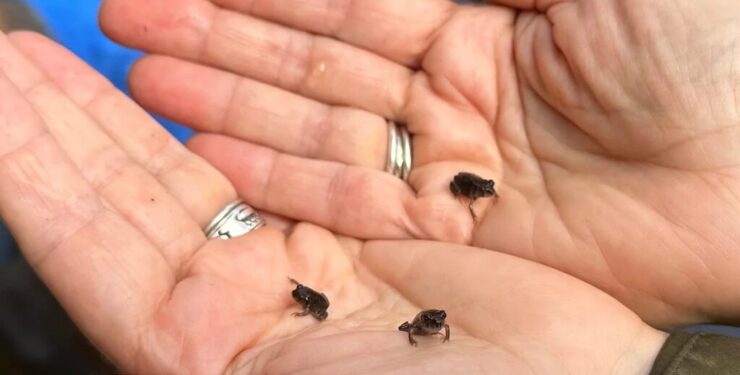Endangered Toads Released At Local Preserve
By Cynthia Drummond for BRVCA
On a recent muggy morning, a team of wildlife biologists and volunteers gathered at the edge of a property owned by the Richmond Rural Preservation Land Trust.
(We have agreed not to reveal the exact locations of the release sites.)
The plan was to release thousands of baby toads, or toadlets, on Land Trust property where a spadefoot toad research project has been underway since 2019.
There are only a couple of remnant populations of Eastern spadefoot toads in Rhode Island, so they are considered endangered.
The toads, which spend much of their lives buried in the soil, get their names from the hard appendages, or “spades” on their back feet, which the toads use to dig themselves into the ground.
A DEM video shows adult spadefoot toads and their digging behavior.
U.S. Fish and Wildlife Biologist Suzanne Paton, who also chairs the Land Trust, stood in a field, awaiting the arrival of the toadlets.
With her were Scott Buchanan, the former Rhode Island Department of Environmental Management herpetologist and several volunteers.
DEM is currently writing a statewide spadefoot reintroduction and recovery plan, but the research is a collaborative effort involving the U.S. Fish and Wildlife Service, DEM, the University of Rhode Island, Roger Williams Park Zoo, the Natural Resources Conservation Service and the Rhode Island Natural History Survey.
As she waited, Paton explained that spadefoots breed when they are between two and three years old, between April and September, in ponds that contain water only for a short time.
“They use ponds that have a very short hydroperiod,” she said.
Buchanan added,
“It can be as extreme as two to three weeks.”
Paton said a couple of weeks would not be enough time for most other species of amphibians, like wood frogs, to reproduce, but spadefoot toad reproduction is brief and intense, triggered by big rainstorms.
“It’s usually when we have one of those big, flashy thunderstorms,” she said. “That triggers them to go and breed, when a pond fills up, and then it doesn’t last very long. So, it’s not every year that they breed.”
The two shallow breeding pools on Land Trust property were created in 2019, an initiative spearheaded by URI professor, Nancy Karraker. Researchers are still waiting to see if any of the toads released in 2019 will breed.
The Release
Lou Perrotti, Director of Conservation at Roger Williams Park Zoo, pulled up to the site and began pulling plastic storage bins out of his car. The bins contained the thousands of toadlets that he had been caring for since July 24, when they were still tadpoles. The tadpoles were rescued, in an effort dubbed “Operation Spadefoot,” from a rapidly – drying pool at a National Wildlife Refuge.
Perrotti explained that feeding the tadpoles was a big job, because they needed to eat twice a day. It was also obvious that he had enjoyed the process.
“In captivity, they’re fed two species of fruit flies and usually pinhead crickets, very tiny, new born crickets that we enrich with calcium and vitamin powder, which gives the toads a nice boost so they can adapt to the environment, which they do really quickly,” he said. “We’ve seen them at our pond releases eating prey right out of the boxes.”
The team split into two groups so they could release toadlets at each of the two Richmond sites. Reaching the first site, it was agreed that the toadlets would be vulnerable to the gray tree frogs and other species living near the pond, so the bins were brought closer to the woods.
“Ten, 20 meters off the edge of the pond is where we should put them,” Perrotti said, before lifting the lid from one of the bins.
Looking like shiny, black dots, the toadlets were surrounded in the bin by moist mosses and had to be carefully removed, counted and placed at the release sites.
Perrotti told the volunteers,
“Don’t be alarmed if you find mortality in the moss, there’s probably going to be some when you’re trying to feed that many animals, making sure they’re all getting two meals a day with that much competition, with me having bins in every room of the house.”
Perrotti reached in the bin and extracted several toadlets. Cupped in his hand, they were counted and then released close to the woods, where they hopped away. Team members were careful to stay clear of the toads’ paths, because they were so tiny and hard to see.
Asked whether saving the toads was worth the time and effort, Paton said it was gratifying to be able to support a native amphibian that had come so close to disappearing from Rhode Island.
“I feel like it’s a species that was native to our area, and part of our native ecosystem, and I just feel like it’s part of our responsibility to help ensure that all those species continue to exist here, and if we can do anything to help, then, for me personally, that’s something I enjoy being a part of,” she said. “As a Land Trust, we’re just super grateful for all the support from all the experts, and people like Lou at the zoo, who actually know how to captive-rear these individuals so we can boost their populations.”

August 27, 2023 @ 12:14 pm
Nice, positive, feel-good article ….. lets have more like this to offset the nasty, negative, feel-bad ones.